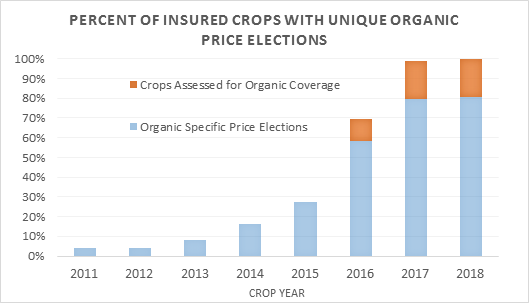|
|
|
The Risk Management Safety Net: Market Penetration and Potential
III. Increased Organic Insurance Offers
Organic agricultural products are an important part of the agricultural sector today, and RMA has worked steadily to provide organic insurance offers and prices to provide an effective risk management safety net for organic producers. To offer organic prices, accurate and sustainable data must be available. Lack of data is the biggest limitation to providing distinct organic prices, and one way that RMA has addressed this issue has been to fund USDA National Agricultural Statistics Service (NASS) surveys for several years targeted to obtain organic crop price information.
Organic Commodities Within the Book of Business
Organic commodity insurance has also increased over time. The following tables show the top 10 crops with the largest amounts of organic liability for 2011 and 2015.
2011 Top 10 Organic Crops by Liability |
|
2015 Top 10 Organic Crops by Liability |
Organic Crop |
Acres Insured |
Liability |
|
Organic Crop |
Acres Insured |
Liability |
Corn |
112,736 |
$101,156,262 |
|
Corn |
178,608 |
$125,967,968 |
Soybeans |
80,173 |
$42,899,018 |
Apples |
12,895 |
$88,078,837 |
Apples |
13,476 |
$40,753,378 |
Soybeans |
91,235 |
$37,773,463 |
Wheat |
223,247 |
$36,583,286 |
Wheat |
255,731 |
$36,917,391 |
Grapes |
10,614 |
$17,295,077 |
Grapes |
11,564 |
$32,491,143 |
Blueberries |
2,551 |
$12,946,228 |
Almonds |
6,181 |
$31,442,273 |
Citrus Fruit/Tree |
7,145 |
$11,137,609 |
Rice |
41,560 |
$26,703,206 |
Cherries |
1,731 |
$11,077,431 |
Tobacco |
6,374 |
$25,504,386 |
Tomatoes |
4,665 |
$10,512,704 |
Tomatoes |
8,455 |
$24,559,440 |
Tobacco |
4,036 |
$10,471,945 |
Blueberries |
2,765 |
$22,225,320 |
The number of Federal crop insurance programs providing organic prices have increased yearly for the last several years. As reported in RMA’s 2017 Annual Organic Report to Congress, for the 2018 crop year, RMA will offer premium organic price elections for 79 of the 98 crops that were identified as having potential for the development of an organic price election, up from 57 crops from 2017.
Growth of Availability of Organic Prices for Insurance
Each year distinct organic prices have been added or expanded to more commodities as shown below:
Before 2014: Premium organic price elections existed for avocados (California), corn, cotton (non-ELS), fresh stonefruit (freestone peaches, nectarines, and plums in California), processing tomatoes (California) and soybeans.
2014 Crop Year: Distinct organic price elections were added for almonds (California), fresh apples (Idaho, Oregon, and Washington), blueberries (all types in California; Early to Late Highbush type in Oregon, and Washington), Concord variety grapes (Oregon and Washington), mint (peppermint), oats, pears (Oregon and Washington) and additional stonefruit (fresh apricots in California; all fresh stonefruit in Idaho, Oregon, and Washington).
2015 Crop Year: Added distinct organic price elections for corn silage, figs, flax, grain sorghum, hybrid corn seed, hybrid sorghum seed, millet, popcorn, silage sorghum, and walnuts.
2016 Crop Year: Added for barley, burley tobacco, cabbage, cigar binder tobacco, cranberries, cultivated wild rice, dry air tobacco, dry peas, flue cured tobacco, forage production (alfalfa in select states), fresh market sweet corn, hybrid sweet corn seed, Maryland tobacco, onions (fresh onions in select states), pinto beans, potatoes, processing clingstone peaches, rice, rye, safflower, sugarcane, sunflower, table grapes, and wheat.
2017 Crop Year: Organic prices were added in Arizona and California for grapefruit, lemons, mandarins, oranges, and tangelos. Grapefruit tree organic prices were added for Florida. New organic price elections were also added for: banana, banana tree, coffee, coffee tree, extra-long staple cotton, fresh market beans, fresh market tomatoes, papaya, papaya tree, peaches, pistachios, and prunes. In addition, an organic price election was added for the cottonseed endorsement.
2018 Crop Year: Added organic price elections for macadamia nuts, early and midseason oranges, late oranges, Rio Red and Star Ruby grapefruit, Ruby Red grapefruit, all other grapefruit, avocado trees, and orange trees. Plans also include adding organic price elections for pasture, rangeland and forage.
What’s Next for Organic Insurance?
Following the 2018 additions, Federal crop insurance will offer premium organic price elections for 79 of the 982 crops that were researched as possible candidates for organic prices.
These 79 crops are the total number of crops for which RMA annually produces a distinct organic price election to provide premium organic price coverage. RMA annually reports to Congress on the progress of developing organic price elections, and these reports are available on the RMA website at www.rma.usda.gov.
The chart below shows the growth of organic price availability in the Federal crop insurance program out of the 98 crops determined possible.

RMA will continue to explore opportunities to obtain organic price data so that insurance offers protecting the risks faced by organic producers can be strengthened with organic prices.
2 The total of 98 crops is based on the distinct number of crops listed in RMA’s online Actuarial Information Browser. (Crops with Actual Revenue History (ARH) plans of insurance, WFRP, nursery, clams, livestock policies, 508(h) submissions other than the cottonseed endorsement, and crop policies that require a marketing contract are not included in the total.)
Contact Information
For more information, contact RMA Public Affairs.
|